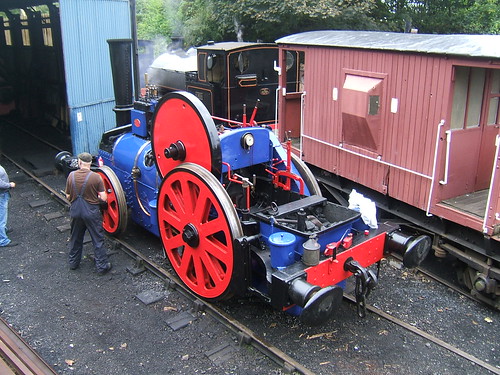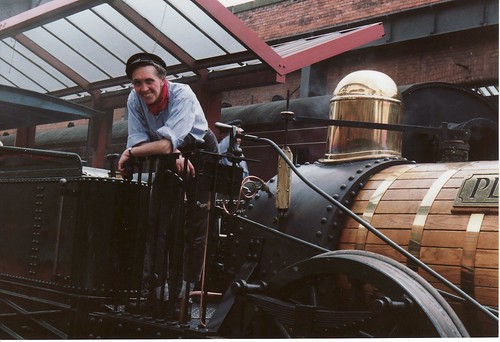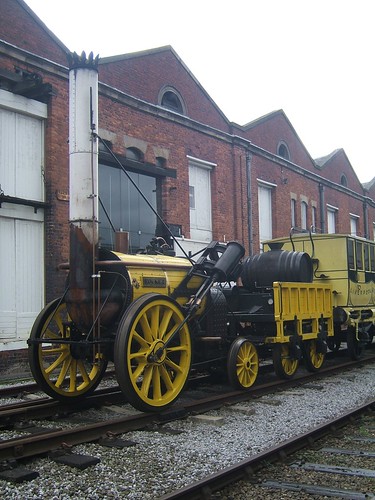This is not a comprehensive review of British locomotive designs with just one driven axle but rather a gentle ramble around some of the candidates.
In a steam engine, steam is used to push a piston (connected to a piston rod) up and down a cylinder. The reciprocating motion of the piston rod is used to rotate an axle via a connecting rod. The axle, in turn, drives a load. Many early stationary engines worked like this without refinements.
But when it comes to locomotives, you really need two cylinders set to provide power at different 'angles' to get over the problems of starting. Early locomotives had two 'driving wheels' connected to the driven axle producing what's often called a 'Single Wheeler' (they would be more accurately described as 'Single Driving Axle' but I suppose since you can only usually see one wheel at a time, 'Single Wheeler' stuck). It's necessary to provide at least one more axle provided with non-powered 'carrying wheels' to make a practical locomotive - a rectangular vehicle with a wheel near each corner.
The 'Rocket' class
The first main-line passenger railway in the world was the Liverpool and Manchester Railway. The events leading up to the building of that line, including the Rainhill Trials (the competition held in 1829 to determine whether locomotive engines could provide the motive power, rather than using stationary engines and cable haulage), are briefly described in the post Early Locomotive Design.
The Stephensons (father George and son Robert) applied all the knowledge acquired building earlier locomotives for colliery haulage in producing 'Rocket', their entry for the Rainhill Trials. Their design placed the driving axle at the front and the carrying axle beneath the footplate which, in Whyte Notation we now call an '0-2-2'. The simplicity of this layout, combined with other sound ideas, particularly the multi-tubular boiler, gave the Stephensons victory in the Trials and the order to provide the motive power for the the Liverpool and Manchester Railway.
In 1830, Stephenson's built seven more of the 'Rocket' class locomotives ('Meteor', 'Comet', 'Arrow', 'Dart', 'Phoenix', 'North Star' and 'Northumbrian') for the Liverpool and Manchester Railway. Various alterations were made - larger cylinders, larger boiler diameter. The water-jacketed firebox was made larger and better integrated with the boiler barrel than in 'Rocket'. Some of these had a recognisable smokebox ('Rocket' had only a large 'elbow' to collect the hot gases from the fire tubes and divert them up the chimney). The inclined cylinders of 'Rocket' were changed for virtually horizontal cylinders, partly to reduce the "hammerblow" effect on the notoriously weak rails of the time.
The historical importance of 'Rocket' means that a number of working and non-working replicas have been built over the years, including the 1979 working replica, now held by the National Railway Museum.The 'Planet' class
The 1979 working replica of 'Rocket' in Manchester to celebrate the 180th birthday of the Liverpool & Manchester Railway.
The pace of development was remarkable. The innovative 'Planet' design - almost as revolutionary as 'Rocket' had been - was also introduced in 1830. The cylinders were changed from 'outside' to 'inside' and placed in the base of the smokebox to reduce condensation losses, producing a '2-2-0' wheel arrangement. The disadvantage of this change was the need to provide a double-crank driving axle for the connecting rods to turn. With the production techniques of the day, broken crank axles were a risk so 'Planet' had both outside frames and inside frames to provide better support to the crank axle. Before the end of 1830, three more 'Planet' class locomotives had been built - 'Majestic', 'Mercury' and 'Mars'.
In 1831, more 'Planet' class were delivered to the Liverpool and Manchester Railway - 'Jupiter', 'Saturn', 'Sun', 'Venus', 'Vulcan', 'Etna', 'Fury' and 'Victory'. 'Vulcan' and 'Fury' were actually built by Fenton, Murray and Company to the Stephensons' design.
The significance of the 'Planet' design led the then Museum of Science and Industry in Manchester (now Museum of Science and Industry and part of the Science Museum Group) to construct a working replica of 'Planet' which was commissioned in 1992. There are a number of posts in this blog which discuss the 'Planet' replica (or the design of the original locomotive), in the section about the Museum of Science and Industry here.Limitation of the 'Single-Wheeler' design
The 'Planet' replica.
As the torque applied at the rail-wheel interface is increased, any locomotive will eventually slip, at a point partly determined by the weight carried by the driving wheels (the 'adhesive weight') and the condition of the rail head. In any 'Single-Wheeler', 'adhesive weight' is less than the total locomotive weight because some weight is taken by the non-powered carrying axle (or axles). 'Adhesion' is briefly discussed in the post Driving the 'Planet' replica.
Although the 'single-wheeler' 'Planet' class excelled on fast passenger trains, many of the earlier designs for collieries had made all the locomotives weight adhesive, either by having four equal-sized wheels with the wheels on each side interconnected by coupling rods (as in 'Locomotion') or by arranging gearing to drive all wheels. At the Rainhill Trials 'Sans Pareil', the only serious competitor to 'Rocket', had four equal-sized wheels with the wheels on each side interconnected by coupling rods (there are pictures of the 'Sans Pareil' replica in the album Liverpool & Manchester 175th).
In 1831, the Stephensons produced a 'modified Planet' with four equal-sized wheels interconnected on each side by coupling rods, providing better adhesion for hauling goods or assisting trains up the inclines. That year, 'Samson' and 'Goliath' were produced, with more to follow in later years.
There's a little more on the 'Samson' class in the post 'Planet' in Perspective.
'The Samson Project' is a modern initiative which hopes to build a working replica of this class either as an '0-4-0' or the later '0-4-2' variant.So why did the Stephensons stay with the 'single-wheeler' design for passenger engines? The production limitations of the time meant that very close dimensional tolerances could not be achieved, resulting in increased 'stiffness' and friction when coupling rods were provided. The reputation of the 'Single-Wheeler' for free-running meant that designers continued to use this format until the end of the nineteenth century.
The 'Patentee' type (and its freight derivative)
Stephenson's continued to develop larger, more powerful engines retaining the single driving axle for passenger trains. The 'Patentee' class adopted an additional pair of carrying wheels giving a '2-2-2' wheel arrangement. The freight versions of the 'Patentee' were usually '0-4-2'. The extra pair of wheels improved the ride, compared with four-wheeled locomotives. The '0-4-2' arrangement lasted for some time and was used by other manufacturers (such as Todd, Kitson and Laird who produced 'Lion'. There are a number of posts on 'Lion', its 'supporters' club' The Old Locomotive Committee and live-steam models of 'Lion' here).
Large 'Single-wheelers'
The top speed of a locomotive could be increased either by making the piston speed higher or by using a larger driving wheel. In the early days, the strength limitations of available materials meant that using larger driving wheels was the better option, although this made locomotives more prone to slipping.
Some designers were tempted to take this business of large driving wheels for higher speeds rather to extremes but, in the hands of a skillful driver, it's remarkable what feats were achieved. A selection of designs are listed below.
'Firefly' class
In 1840, Daniel Gooch introduced onto Brunel's Great Western Railway the 'Firefly' class of broad gauge '2-2-2' with driving wheels just over 7 feet in diameter. This very successful design ultimately extended to 62 locomotives. There's a description on Wikipedia here.
There is a full-size working replica of 'Firefly' described on The Broad Gauge Society site here. This replica is at Didcot Railway Centre, where it is occasionally steamed on a special broad gauge railway described here.'Iron Duke' class
'Firefly is depicted on a medal commemorating the 150th Anniversary of the GWR.
'Great Western' followed in 1846, also originally built as a '2-2-2' but with 8 feet diameter driving wheels. Upon breaking its leading axle, the locomotive was rebuilt as a 4-2-2 (with the leading carrying wheels fixed were in the frames, not arranged as a bogie), then becoming one of the fast, capable 'Iron Duke' class, described on 'Wikipedia' here.
The importance of 'Iron Duke' induced the Science Museum to produce a full-size working replica in 1981, in time for GWR 150th Anniversary which was celebrated in 1985. This replica is now held by the National Railway Museum and there's a little more here. There's more about the replica 'Iron Duke' on The Broad Gauge Society site here.'Columbine' class
The replica 'Iron Duke' on display at Toddington (Photo: Rob Speare).
In 1845, Alexander Allen built 'Columbine' at Crewe for the Grand Junction Railway (which became part of the London & North Western Railway the following year). This '2-2-2' had outside cylinders and many features perpetuated by Crewe for many years. The locomotive was not finally withdrawn until 1902 and is now part of the 'National Collection', displayed in LNWR "blackberry black' lined livery. There's a brief entry on the National Railway Museum site here. The 'The Victorian Web' has a nice collection of photographs here (although the text is a little suspect).
 'Columbine' on display in York (Photo: NRM).
'Columbine' on display in York (Photo: NRM).
I first saw this locomotive over 50 years ago in the Paint Shop at Crewe, along with '0-4-2' 'Lion'.
'Crampton' designs and 'Cornwall'
In 1846, a design by Crampton featured a low-slung boiler for stability and a single driving axle placed well back, allowing fairly large wheels for speed. The design became more popular in France and Germany although a number were operated in Britain. The most remarkable example in this country was the 6-2-0 'Liverpool' with 8 foot diameter driving wheels built in 1848 for the London & North Western Railway. The 'Cramptons' are described on Wikipedia here.
In 1847, Francis Trevithick produced 'Cornwall' for the London & North Western Railway as a '4-2-2' with 8 foot 6 inch diameter driving wheels, intended as an 'improved Crampton'. To keep the centre of gravity low, the unusual boiler was placed below the driving axle! In 1858, Ramsbotton carried out a major rebuild as a '2-2-2' retaining the large driving wheels but with the driving axle conventionally passing underneath the boiler, as described on Wikipedia here.
 'Cornwall' on display at Shildon (Photo: James E. Petts via Creative Commons).
'Cornwall' on display at Shildon (Photo: James E. Petts via Creative Commons).
When I became a volunteer at Birmingham Railway Museum in the late 1980s, 'Cornwall' was in store in the shed. I sat on the footplate many times imagining the locomotive in steam.
'Stirling Singles'
On the Great Northern Railway in 1870, Patrick Stirling introduced a very successful class of 4-2-2 'Singles', finally totalling 53 locomotives, with a driving wheel diameter of 8 foot 1 inch. There's a short 'Wikipedia article here.

Stirling 4-2-2 displayed at Doncaster in 2003 (Photo: Our Phellap).
Caledonian Railway 'Single' 123
The most famous of the Caledonian Railway 'Singles' is the preserved '123' which participated in the Race to the North. Dugald Drummond adopted 7 foot driving wheels for the 123 built by Neilson in 1886 (Neilson later became part of North British Locomotive Company Limited and there's a short history here).
 Caledonian '123' (Photo: Glasgow Museums).
Caledonian '123' (Photo: Glasgow Museums).
Midland Railway 'Singles'
As late as 1896, Samuel Waite Johnson produced the '115' class for the Midland Railway with driving wheels around 7 foot 9.5 inches diameter. They could certainly 'run' and the appearance of the single driving wheel at speed (or their tendency to slip) suggested their nickname 'Spinner'. There's a Wikipedia article here).

'Spinner' at Rainhill in 1980 (Photo: Antony Guppy).
An unusual 'Single Wheeler'
Aveling Porter are best known for their road rollers and traction engines but they did manufacture some railway locomotives for shunting purposes. Most of these were four-coupled but there is a preserved '2-2-0' Well Tank built in 1926 named 'The Blue Circle' which manages with one cylinder and a flywheel. There's some information about this remarkable survivor on the Bluebell Railway website here, and there's a very short post in my blog here which links to an album of pictures. This locomotive has also carried the name 'Fergus', commemorating its appearance in 'Thomas and Friends'.
 'Blue Circle' being prepared for service by Mick on the Battlefield Line in 2007.
'Blue Circle' being prepared for service by Mick on the Battlefield Line in 2007.
The Large 'Single-wheeler' era ends
With the improvement in materials and production technology, it became possible to permit higher piston speeds with safety and the need for very large driving wheels declined. In this country, a driving wheel around 6 foot 8.5 inches diameter became the norm for fast running. Increasing train loads meant that a single driving axle was inadequate and 2, 3 or 4 axles would be coupled together. Again, the improvements in production techniques meant that the power losses originally associated with coupled wheels were acceptable.
Single Wheelers I've driven
'Rocket' replica
My first involvement with the 'Rocket' replica was at a Gala at Birmingham Railway Museum (late 1980s, I think) when I spent some time on the footplate with Ray Towell from the National Railway Museum. 'Rocket' visited the Museum of Science and Industry in Manchester (now Museum of Science and Industry) in 2005 and again in 2010 (celebrating 175 and 180 years, respectively, of the Liverpool and Manchester Railway). I managed to do a bit of driving and firing on both occasions. There's a little more about these events (with links to pictures) here.
'Planet' replica
When the 'Planet' replica was being built at the Museum of Science and Industry in Manchester, I was already a volunteer driver there. I did a few odd jobs during erection. I remember balancing on top of the boiler as the overhead crane lowered the tall chimney which I had to guide into its mounting flange on the smokebox.
In October 1992, there were lots of special steamings following the official launch. The locomotive went out on two sets of 'Trials', firstly at the Great Central Railway (at Loughborough) then to the East Lancashire Railway (at Bury). I was involved on both these visits and there's some information in the post The Planet Replica. We also made a visit to the National Railway Museum (at York) for a Gala, where we ran 'Planet' up and down on a special demonstration line without conveying passengers but I'm not sure of the date. 'Planet' did make a number of subsequent visits to other sites, although I wasn't personally involved in these. I was involved in driving 'Planet' at Manchester during the 175 and 180 year celebrations of the opening of the Liverpool and Manchester Railway and during the Transport Festival (and Great Garratt Gathering) in 2009. There's a little about the 175 and 180 year events here and a short report on the Transport Festival here.
I continued to drive in Manchester on the regular weekend service and a few special events (I well remember the Dalek Invasion in Manchester) until some time after 'Planet's' 21st birthday (described here).
 'Planet' replica (and a much younger Jan) at the original platform at Manchester some time in 1992-1993 (Photo: L. Walker, Wigan).
'Planet' replica (and a much younger Jan) at the original platform at Manchester some time in 1992-1993 (Photo: L. Walker, Wigan).
'Iron Duke' replica
When I was at York with the 'Planet' replica (mentioned above) the 'Rocket' replica was giving passenger rides on the standard gauge demonstration line and the 'Iron Duke' was giving passenger rides on the broad gauge demonstration line. They offered me a drive on either (not both) at the end of the public service. I elected for 'Iron Duke' which remains the only 7-foot gauge locomotive I've driven, although I've driven 5-foot 6-inch gauge in India (see the post My First Trip to India (continued)) and 5-foot gauge in Ukraine (see the post Ukraine 2005).
'The Blue Circle'
Mick, the owner of 'Blue Circle' has always encouraged my interest in his unusual motive power and one day he let me fire and drive up and down at Shackerstone on the Battlefield Line. It was an interesting experience!
 'Blue Circle' at Shackerstone in 2010: Driver's view.
'Blue Circle' at Shackerstone in 2010: Driver's view.
Related articles on other sites
George Stephenson.
Robert Stephenson.
Related articles on this web site
Early Locomotive Design.
The Planet Replica.
'Planet' in Perspective.
Liverpool & Manchester 180th Celebrations.
'Planet' at MOSI - The First 21 Years.
Driving the 'Planet' replica.
Aveling & Porter Locomotive.
My pictures
Liverpool & Manchester 175th.
Liverpool & Manchester 180th.

